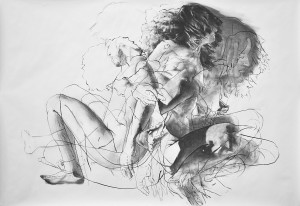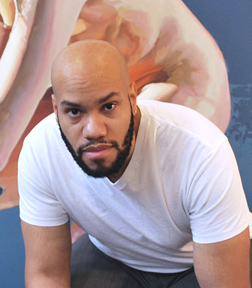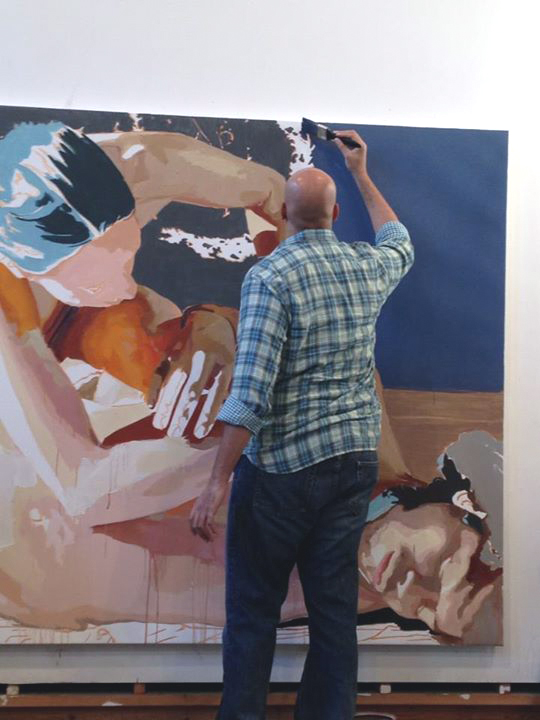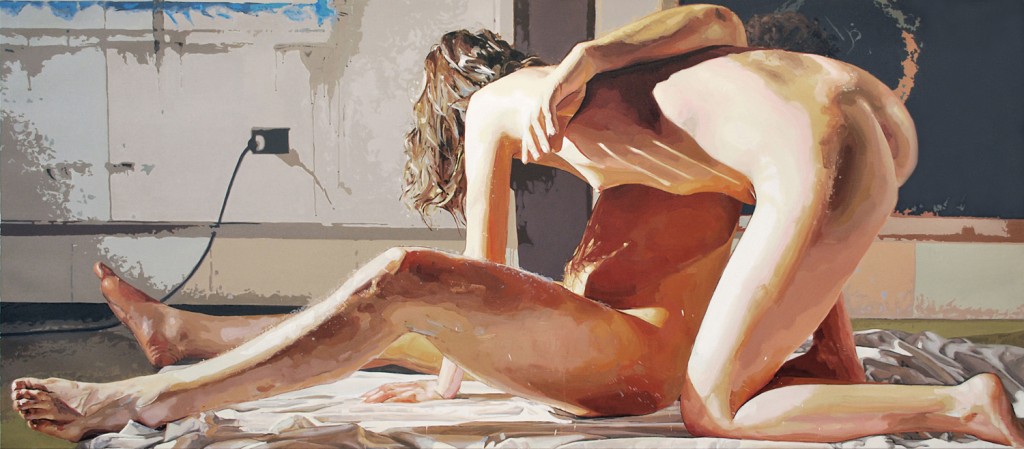BY FRANK JUAREZ GALLERY + GREYMATTER GALLERY
I recently participated in a Q & A collaborative project that features a new artist each day during 2014. Read below or view original post.
PATRICK EARL HAMMIE – CHAMPAIGN, ILLINOIS
 365 DAYS | 365 ARTISTS: Briefly describe the work you do.
365 DAYS | 365 ARTISTS: Briefly describe the work you do.
PATRICK EARL HAMMIE: Perhaps more than any other form of image-making, figurative painting has often been interpreted as a reflection of the values of period in which it is produced. My work investigates the expectations built into this canonical genre, probing and dismantling the idealizing impulses that have historically shaped it. I focus specifically on constructions of gender and race, putting pressure on these categories as a means of expanding understanding of identity. I investigate how male artists have imagined and visually formulated the nude figure in the history of Western art, and have spent the past several years using the pictorial traditions of the Old Masters, body language, and narrative to reconfigure inherited conceptions of ideal beauty and heroic nudity. In my practice, painting the figure entails encountering and interrogating the heroizing, idealizing tradition of the nude in Western Art in which black and brown male bodies have been objectified and dehumanized. Representing the black male nude by making my own body the subject of monumental canvases that play on effects of distortion and masculine prowess, I remake what the nude does and how it produces meaning.
365: Tell us a little about your background and how that influences you as an artist.
PEH: I was born 1981 in New Haven, CT. I was raised in West Haven, CT but moved back and forth between there and Hartsville, SC until graduate school. When I was younger, I studied martial arts, played baseball and football, and sang in concert choirs. These experiences informed my personality, and developed the discipline and work ethic that I pull from today. I earned my BA from South Carolina’s Coker College and my MFA in Painting from the University of Connecticut. Before graduate school, most of my works were drawings that explored intimations of my current practice. Artist like Sidney Goodman, Käthe Kollwitz, and Charles White influenced me. During graduate school I moved toward painting as my main medium, and was drawn to artists such as Francis Bacon, Renee Cox, Lucien Freud, Leon Golub, and Barkley L. Hendricks.
365: The concept of the “artist studio” has a broad range of meanings, especially in contemporary practice. The idea of the artist toiling away alone in a room may not necessarily reflect what many artists do from day to day anymore. Describe your studio practice and how it differs from (or is the same as) traditional notions of “being in the studio.”
PEH: I feel my studio routine is pretty traditional. When I walk into my studio, I turn on music; nothing happens in the studio without music. Next, I look at the works in progress and plan for the day, while I check my email and social media. Then, I mix the colors that I need, lay out my materials, and paint. Before I leave I clean up. I try to keep a clean studio so I have more permission to make a mess when I’m working. During studio visits people sometimes comment on my palette being immaculate (paint is usually in a grid). I assure them that it’s only that way when I’m not actually painting.
365: When do you find is the best time of day to make art? Do you have time set aside every day, every week or do you just work whenever you can?
PEH: I usually work on my paintings and drawings in the studio from about 12 – 6pm every weekday. From 7 – 9pm I work on other studio business—emails, essays, lectures, website, etc. On Saturdays, it’s an all day affair.
365: How has your work changed in the last five years? How is it the same?
PEH: My previous projects put my un-idealized body in conversation with the idealized male form and represent myself perched atop precarious pedestals, visualizing an effort to reshape myself and confronting impressions of the objectified black body. My recent project, Significant Other, represents a shift in my practice, as a female figure becomes a predominant agent of content. It presents a female and a male figure locked in a physical dialogue, hefting weight, and relocating the perceptions of ruined and objectified bodies that recall and carry on complex legacies of suffering and struggle. Informed by historical representations of Otherness and recent shifts that locate women and people of color as central influencers of culture and politics, this series reorients inherited expectations and makes room for these bodies to populate new stations. Drawing on the emotive qualities of Romanticist painting and its use of heroic proportions to engage with political and humanistic expression, I imagine bodies as occasions for us to encounter difference toward considering their capacity for establishing new narratives.
More examples of my work can be viewed here.
365: If you had an occupation outside of being an artist, what would that be and why?
PEH: I’d probably write fiction. I might still do that.
About
 PATRICK EARL HAMMIE is an artist best known for his monumental portraits working primarily with themes related to identity, history and narrative. He received his BA from South Carolina’s Coker College and his MFA in Painting from the University of Connecticut. Hammie is currently an assistant professor at the University of Illinois at Urbana-Champaign, and has lectured at Purdue University, University of North Carolina, and the Wadsworth Atheneum Museum of Art in Connecticut. In 2008, he received the Alice C. Cole ’42 Fellowship through Wellesley College, and in 2011, was an artist in residence at the John Michael Kohler Art Center. He has exhibited in galleries throughout the U.S. and abroad including Ruchika’s Art Gallery in Panjim Goa, Kunst in der Carlshütte in Büdelsdorf, the Painting Center in New York, and the Indianapolis Art Center. His work is in several public collections including the Kohler Company, the Kinsey Institute at Indiana University, and the William Benton Museum of Art. Hammie has received awards from the Tanne Foundation and the Alliance of Artist Communities with the Joyce Foundation, and an Arnold O. Beckman Research Award.
PATRICK EARL HAMMIE is an artist best known for his monumental portraits working primarily with themes related to identity, history and narrative. He received his BA from South Carolina’s Coker College and his MFA in Painting from the University of Connecticut. Hammie is currently an assistant professor at the University of Illinois at Urbana-Champaign, and has lectured at Purdue University, University of North Carolina, and the Wadsworth Atheneum Museum of Art in Connecticut. In 2008, he received the Alice C. Cole ’42 Fellowship through Wellesley College, and in 2011, was an artist in residence at the John Michael Kohler Art Center. He has exhibited in galleries throughout the U.S. and abroad including Ruchika’s Art Gallery in Panjim Goa, Kunst in der Carlshütte in Büdelsdorf, the Painting Center in New York, and the Indianapolis Art Center. His work is in several public collections including the Kohler Company, the Kinsey Institute at Indiana University, and the William Benton Museum of Art. Hammie has received awards from the Tanne Foundation and the Alliance of Artist Communities with the Joyce Foundation, and an Arnold O. Beckman Research Award.


